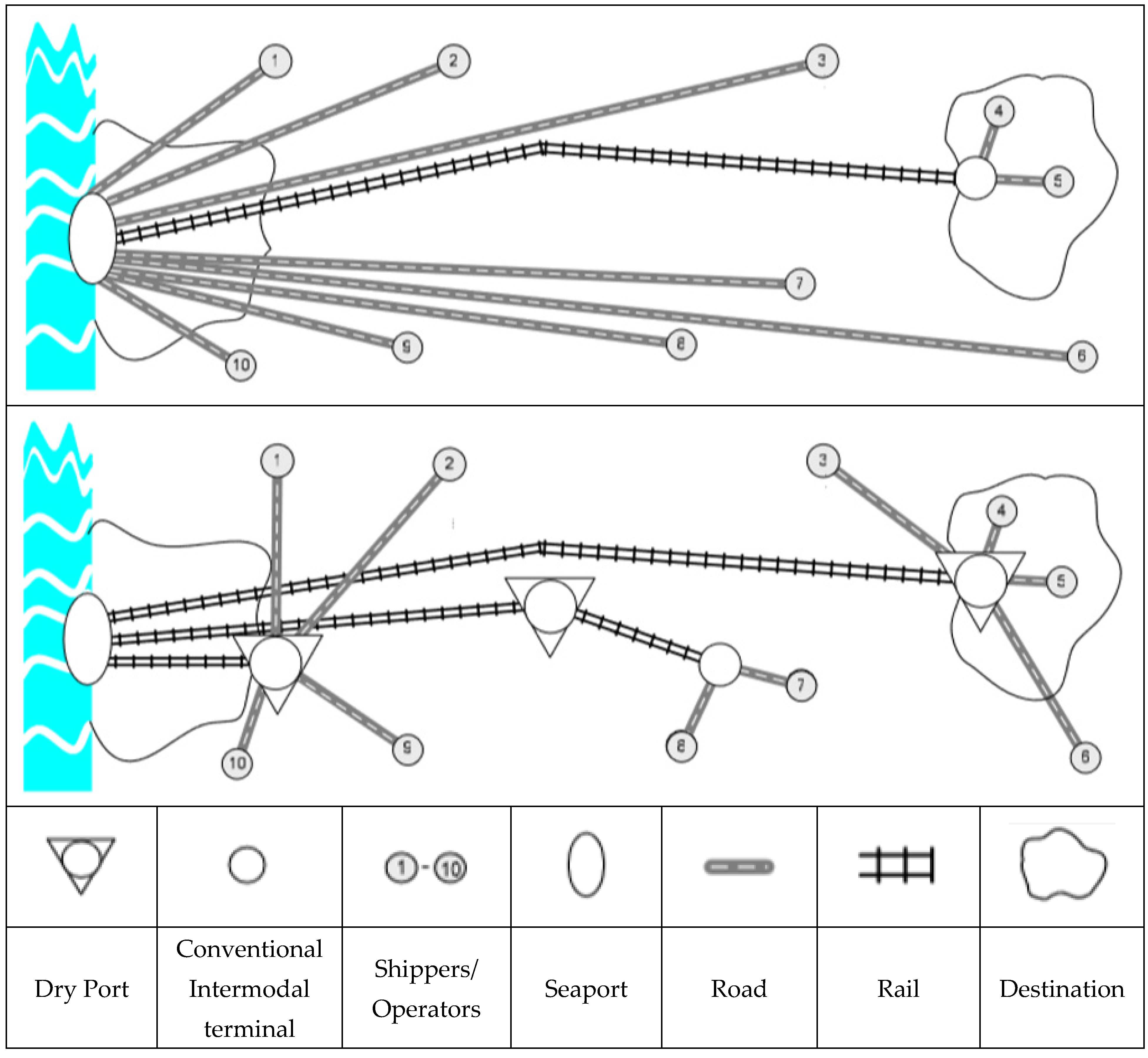Determining Optimal Dry Port Location for Seaport Rijeka Using AHP Decision-Making Methodology
Abstract
1. Introduction
2. Status of Seaport Rijeka in Croatian and EU Transport Network
3. Establishing a Dry Port as Solution to Seaport Rijeka Expansion
4. Determining Influential Factors of Dry Port Establishment
5. AHP Decision-Making Methodology to Determine the Optimal Dry Port Location for Seaport Rijeka
- For selection of close dry port location, alternatives are Miklavlje, Škrljevo, Lokve and Delnice;
- For selection of medium-distance dry port location, alternatives are Zagreb-RTZ, Velika Gorica, Dugo Selo, Ivanić Grad;
- For selection of distant dry port location, alternatives are Slavonski Brod, Osijek, Vinkovci, Vukovar.
6. Results
6.1. Optimal Close Dry Port Location for Seaport Rijeka
6.2. Optimal Medium-Distance Dry Port Location for Seaport Rijeka
6.3. Optimal Distant Dry Port Location for Seaport Rijeka
6.4. Selected Dry Port Locations for Seaport Rijeka
7. Discussion
Author Contributions
Funding
Institutional Review Board Statement
Informed Consent Statement
Data Availability Statement
Conflicts of Interest
References
- Trans-European Transport Network (TEN-T). Available online: https://ec.europa.eu/transport/sites/transport/files/themes/infrastructure/ten-t-guidelines/corridors/doc/ten-t-corridor-map-2013.pdf (accessed on 3 March 2020).
- Lovrić, I.; Bartulović, D.; Viduka, M.; Steiner, S. Simulation analysis of seaport rijeka operations with established dry port. Sci. J. Marit. Res. 2020, 34, 129–145. [Google Scholar] [CrossRef]
- Black, J.; Roso, V.; Marušić, E.; Brnjac, N. Issues in dry port location and implementation in metropolitan areas: The case of Sydney, Australia. Trans. Marit. Sci. 2018, 7, 41–50. [Google Scholar] [CrossRef]
- Cullinane, K.; Wilmsmeier, G. The contribution of the dry port concept to the extension of port life cycles. In Handbook of Terminal Planning; Springer: New York, NY, USA, 2011. [Google Scholar]
- Hanaoka, S.; Regmi, M.B. Promoting intermodal freight transport through the development of dry ports in Asia: An environmental perspective. Int. Assoc. Traffic Saf. Sci. Res. 2011, 35, 16–23. [Google Scholar] [CrossRef]
- Rogić, K.; Rožić, T.; Kolarić, G. Functionality of logistics distribution centers as a inland port terminal (dry port terminals)—Case study city of Zagreb. In Proceedings of the Conference of Planning and Development of Sustainable Transport System, Zagreb, Croatia, 21–23 October 2013. [Google Scholar]
- Cezar-Gabriel, C. Performance assessment in operating dry ports. Annals of the university of Oradea. Econ. Sci. Ser. 2010, 19, 934–938. [Google Scholar]
- Crainic, T.G.; Dell’Olmo, P.; Ricciardi, N.; Sgalambro, A. Modeling dry-port-based freight distribution planning. Transp. Res. Part C Emerg. Technol. 2015, 55, 518–534. [Google Scholar] [CrossRef]
- Dragović, B.; Tzannatos, E.; Park, N.K. Simulation modelling in ports and container terminals: Literature overview and analysis by research field, application area and tool. Flex. Serv. Manuf. J. 2017, 29, 4–34. [Google Scholar] [CrossRef]
- Dundović, Č.; Hess, S.; Šantić, L. Load and capacity calculation of the container terminal of the port of Ploče. J. Marit. Res. 2006, 20, 79–95. (In Croatian) [Google Scholar]
- Mlinarić, T.J.; Rogić, K.; Rožić, T. Methodology for determining dry port system transport network—Case study port of Rijeka-Zagreb. In DAAAM International Scientific Book; DAAAM International Vienna: Vienna, Austria, 2011; pp. 133–146. [Google Scholar]
- TEN-T Days-Croatia’s Position in the European Union Transport Network. Available online: https://mmpi.gov.hr/print.aspx?id=16552&url=print (accessed on 2 March 2020).
- Jugović, T.P.; Baričević, H.; Karleuša, B. Multi-criteria optimization of competitiveness of the Pan-European corridor V 8 competitiveness. Promet-Traffic Transp. 2006, 18, 189–195. (In Croatian) [Google Scholar]
- Transport Development Strategy of the Republic of Croatia (2017–2030). Available online: https://vlada.gov.hr/UserDocsImages/ZPPI/Strategije/MMPI%202017-2030%20STRAT%20PROM%20RZV%20RH%2025-8_17.pdf (accessed on 2 May 2020). (In Croatian)
- Božičević, J. Traffic corridors between central Danube and Adriatic region on territory of Croatia. Promet 1996, 5, 1–5. [Google Scholar]
- Božičević, J. Status and Future of Croatian Railways; Croatian Government: Zagreb, Croatia, 1996. (In Croatian) [Google Scholar]
- Božičević, J.; Perić, T. Baltic-Adriatic transport corridors—Conceptual settings for traffic network optimization. Ekon. Pregl. 2005, 56, 185–203. (In Croatian) [Google Scholar]
- Steiner, S. Valorization of the Intermodal Logistics Corridor Ploče-Mostar-Sarajevo-Vukovar (Central Adriatic-Danube); Croatian Academy of Sciences and Arts: Zagreb, Croatia, 2017. (In Croatian) [Google Scholar]
- Seaport Rijeka, Management Presentation. Available online: www.lukarijeka.hr/Data/Files/194_201506081251975/LKRI.pdf (accessed on 5 April 2020).
- Seaport Rijeka, Financial Reports. Available online: https://lukarijeka.hr/financijska-izvjesca/ (accessed on 21 June 2020).
- Lovrić, I.; Bartulović, D.; Steiner, S. Concept of the decision-making model for establishment of dry port on the sample of Rijeka seaport. Our Sea 2020, 67, 232–243. [Google Scholar] [CrossRef]
- Ballis, A.; Golias, J. Comparative evaluation of existing and innovative rail–road freight transport terminals. Transp. Res. Part A Policy Pract. 2002, 36, 593–611. [Google Scholar] [CrossRef]
- Bergqvist, R.; Falkemark, G.; Woxenius, J. Establishing intermodal terminals. World Rev. Intermodal Transp. 2010, 3, 285–302. [Google Scholar] [CrossRef]
- Rodrigue, J.P.; Notteboom, T. Dry ports in European and North American intermodal rail systems: Two of a kind? Res. Transp. Bus. Manag. 2012, 5, 4–15. [Google Scholar] [CrossRef]
- Roso, V. Emergence and significance of dry ports. Balt. Transp. J. 2010, 38, 44–45. [Google Scholar]
- Roso, V.; Lumsden, K. Review of dry ports. Marit. Econ. Logist. 2010, 12, 196–213. [Google Scholar] [CrossRef]
- Roso, V. Sustainable intermodal transport via dry ports—Importance of directional development. World Rev. Intermodal Transp. Res. 2013, 4, 140–156. [Google Scholar] [CrossRef]
- Bask, A.; Roso, V.; Andersson, D.; Hämäläinen, E. Development of seaport-dry port dyads: Two cases from Northern Europe. J. Transp. Geogr. 2014, 39, 85–95. [Google Scholar] [CrossRef]
- Chen, J.; Fei, Y.; Zhang, F.; Jing, C. Evaluating correlations between a seaport and its dry ports: Case study of Xiamen port in China. Discret. Dyn. Nat. Soc. 2018, 2018, 1–15. [Google Scholar] [CrossRef]
- Roso, V.; Woxenius, J.; Lumsden, K. The dry port concept: Connecting container seaports with the hinterland. J. Transp. Geogr. 2009, 17, 338–345. [Google Scholar] [CrossRef]
- Shi, X.; Li, H. Developing the port hinterland: Different perspectives and their application to Shenzhen Port, China. Res. Transp. Bus. Manag. 2016, 19, 42–50. [Google Scholar] [CrossRef]
- Wang, G.W.; Zeng, Q.; Li, K.; Yang, J. Port connectivity in a logistic network: The case of Bohai Bay, China. Transp. Res. Part E Logist. Transp. Rev. 2016, 95, 341–354. [Google Scholar] [CrossRef]
- Wilmsmeier, G.; Monios, J.; Lambert, B. The directional development of intermodal freight corridors in relation to inland terminals. J. Transp. Geogr. 2011, 19, 1379–1386. [Google Scholar] [CrossRef]
- Woxenius, J.; Bergqvist, R. Hinterland transport by rail—Comparing the Scandinavian conditions for maritime containers and semi-trailers. In Proceedings of the International Association of Maritime Economists Conference (IAME), Copenhagen, Denmark, 24–26 June 2009; pp. 1–15. [Google Scholar]
- Oláh, J.; Nestler, S.; Nobel, T.; Harangi-Rákos, M.; Popp, J. Development of dry ports in Europe. Int. J. Appl. Manag. Sci. 2018, 10, 269–289. [Google Scholar] [CrossRef]
- Lovrić, I.; Bartulović, D.; Steiner, S. The influence of dry port establishment on regional development through regional development index. Trans. Marit. Sci. 2020, 9, 293–315. [Google Scholar] [CrossRef]
- Woxenius, J.; Roso, V.; Lumsden, K. The dry port concept—Connecting seaports with their hinterland by rail. In Proceedings of the First International Conference on Logistics Strategy for Ports (ICLSP), Dalian, China, 22–26 September 2004. [Google Scholar]
- Roso, V. Factors influencing implementation of a dry port. Int. J. Phys. Distrib. Logist. Manag. 2008, 38, 782–798. [Google Scholar] [CrossRef]
- Awad Núñez, S.; González-Cancelas, N.; Camarero-Orive, A. Setting of weighting factors influencing the determination of the location of dry ports using a DELPHI methodology. In Proceedings of the 1st International Virtual Scientific Conference, Żylina, Slovakia, 10–14 June 2013. [Google Scholar]
- Awad-Núñez, S.; González-Cancelas, N.; Camarero-Orive, A. Application of a model based on the use of DELPHI methodology and multicriteria analysis for the assessment of the quality of the Spanish dry ports location. Procedia Soc. Behav. Sci. 2014, 162, 42–50. [Google Scholar] [CrossRef]
- Awad-Núñez, S.; González-Cancelas, N.; Camarero-Orive, A. Quality evaluation of Spanish dry ports location based on Delphi methodology and multicriteria analysis. In Proceedings of the 2nd Electronic International Interdisciplinary Conference, Zilina, Slovakia, 2–6 September 2013; pp. 502–508. [Google Scholar]
- Linstone, H.A.; Turoff, M.; Helmer, O. The Delphi Method Techniques and Applications Los Angeles; University of Southern California: Los Angeles, CA, USA, 2002. [Google Scholar]
- Saaty, T.L. The Analytic Hierarchy Process, 2nd ed.; RWS Publications: Pittsburg, CA, USA, 1996. [Google Scholar]
- Saaty, T.L.; Vargas, L.G. Models, Methods, Concepts & Applications of the Analytic Hierarchy Process; Kluwer Academic Publisher: Dordrecht, The Netherlands, 2001. [Google Scholar]
- The Analytic Network Process. Available online: http://www.iors.ir/journal/article-1-27-en.pdf (accessed on 17 April 2020).
- Vinovrški, D. Application of Multi-Criteria Analysis Method in Decision Making. Master’s Thesis, Faculty of Economics and Tourism, Pula, Croatia, 2016. (In Croatian). [Google Scholar]
- Šimunović, L.; Grgurević, I.; Pašagić-Škrinjar, J. Selecting optimal pedestrian crossing using multi-criteria decision-making. Traffic Manag. 2010, 22, 105–116. [Google Scholar] [CrossRef][Green Version]
- Srđević, B.; Srđević, Z.; Zoranović, T. PROMETHEE, TOPSIS and CP in multi-criteria decision-making in agriculture. Letop. Naučnih Rad. 2002, 26, 5–23. (In Croatian) [Google Scholar]
- Deluka-Tibljaš, A.; Karleuša, B.; Dragičević, N. Review of the application of multi-criteria analysis methods in making decisions on transport infrastructure. Građevinar 2013, 65, 619–631. (In Croatian) [Google Scholar]
- Hunjak, T.; Jakovčević, D. Multi-criteria models for ranking and comparing banks. In Proceedings of Faculty of Economics; Faculty of Economic: Belgrade, Serbia, 2013. (In Croatian) [Google Scholar]
- Arslan, T. A hybrid model of fuzzy and AHP for handling public assessments on transportation projects. Transportation 2009, 36, 97–112. [Google Scholar] [CrossRef]
- Roso, V. Emergence and significance of dry ports—The case of the port of Göteborg. World Rev. Intermodal Transp. Res. 2009, 2, 296–310. [Google Scholar] [CrossRef]
- Do, N.; Nam, K.; Le, Q. A consideration for developing a dry port system in Indochina area. Marit. Policy Manag. 2011, 38, 1–9. [Google Scholar] [CrossRef]
- Spatial Plan of the Municipality of Matulji. Available online: http://matulji.hr/pocetna/prostorni-planovi/ (accessed on 2 May 2020).
- Rail Freight Corridors (RFCs) Map. Available online: http://rne.eu/wp-content/uploads/RFC-MAP-2017.pdf (accessed on 2 May 2020).
- Master Plan of the City of Vinkovci for Traffic. Available online: http://viavinkovci.hr/wp-content/uploads/2019/11/Master-plan-Grada-Vinkovaca-za-promet.pdf (accessed on 2 May 2020).
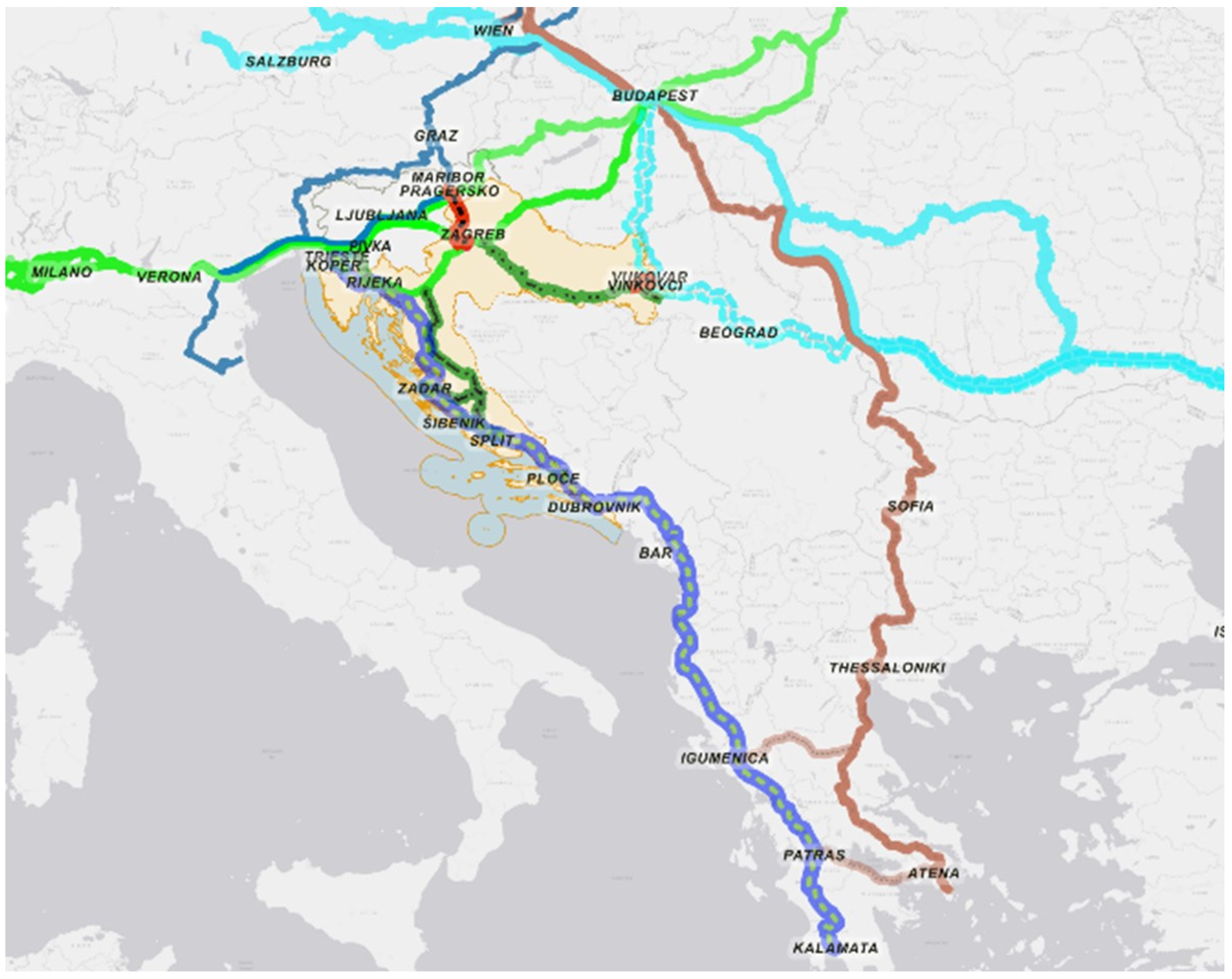
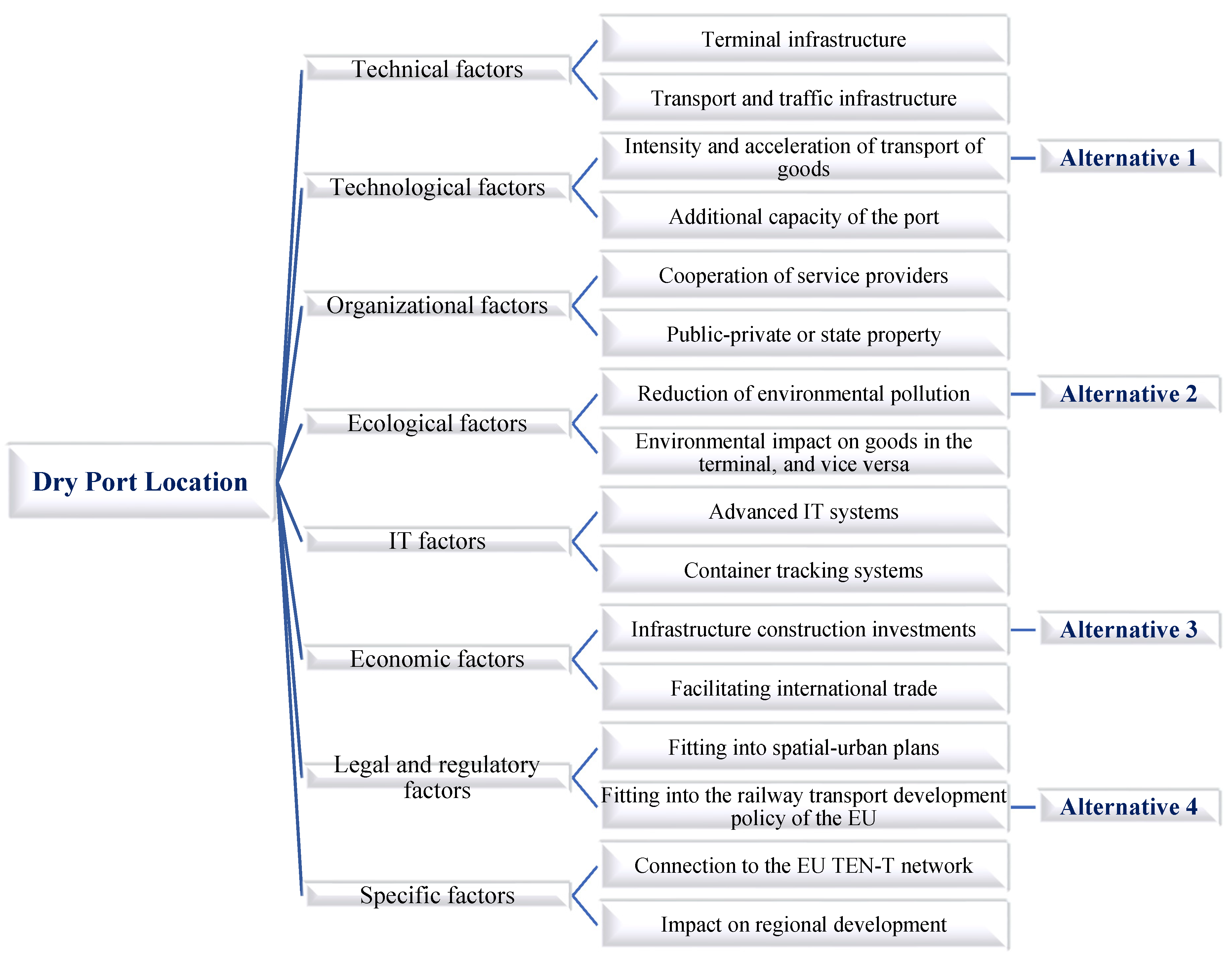
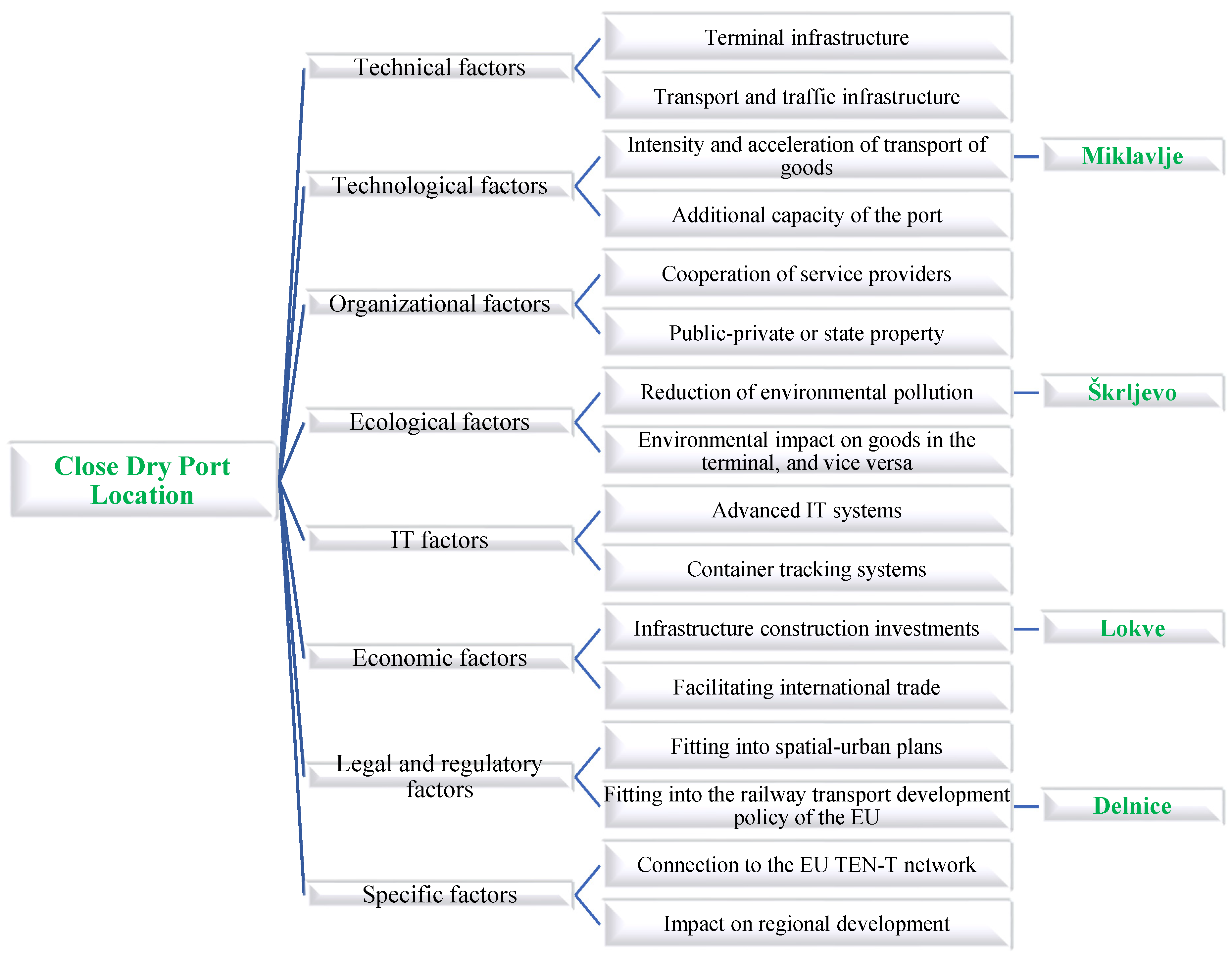
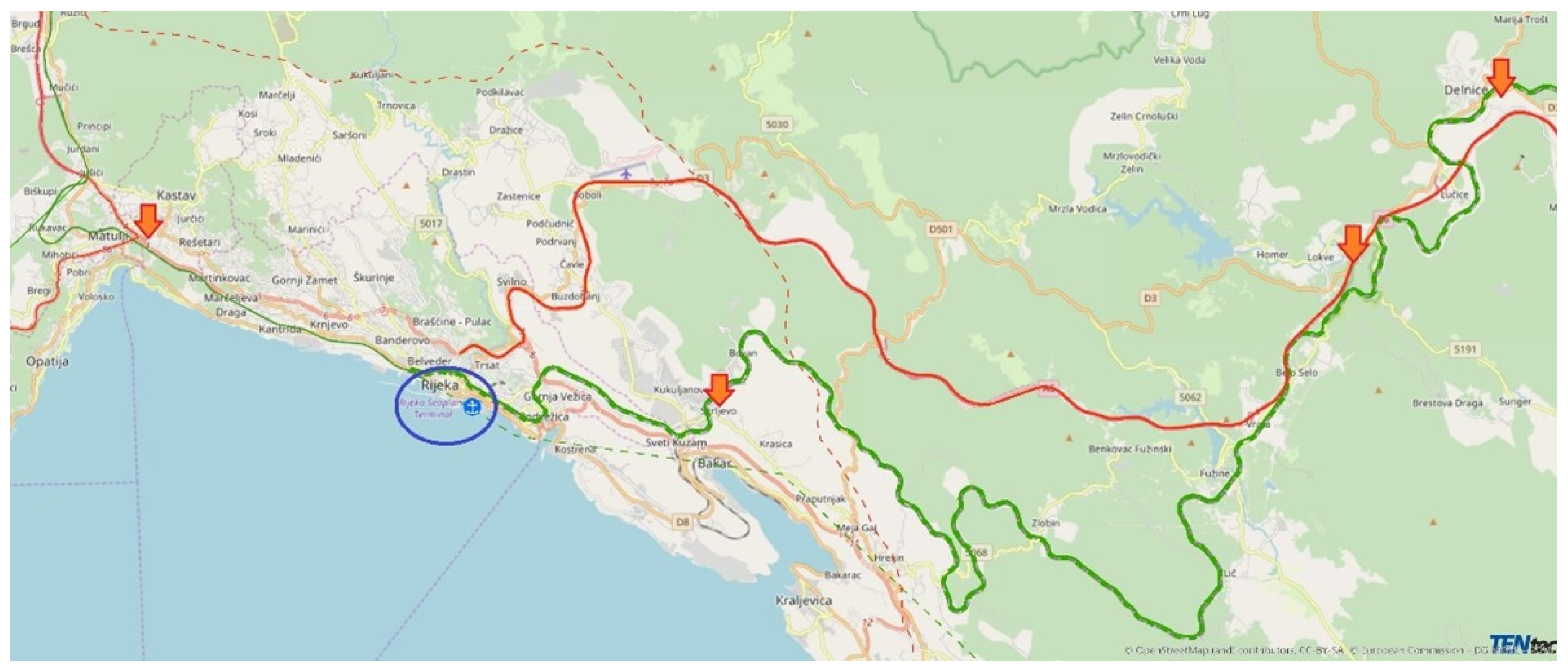
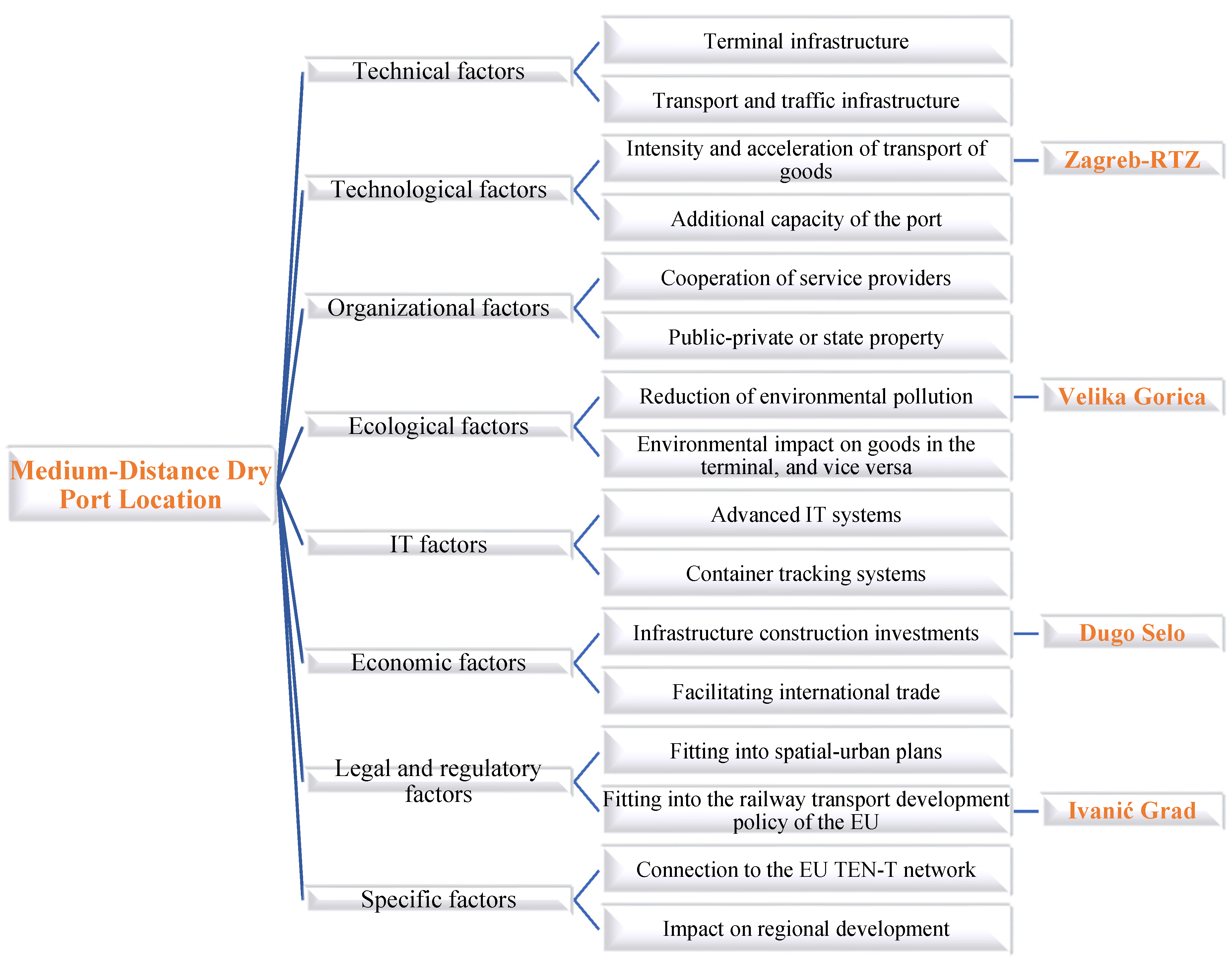
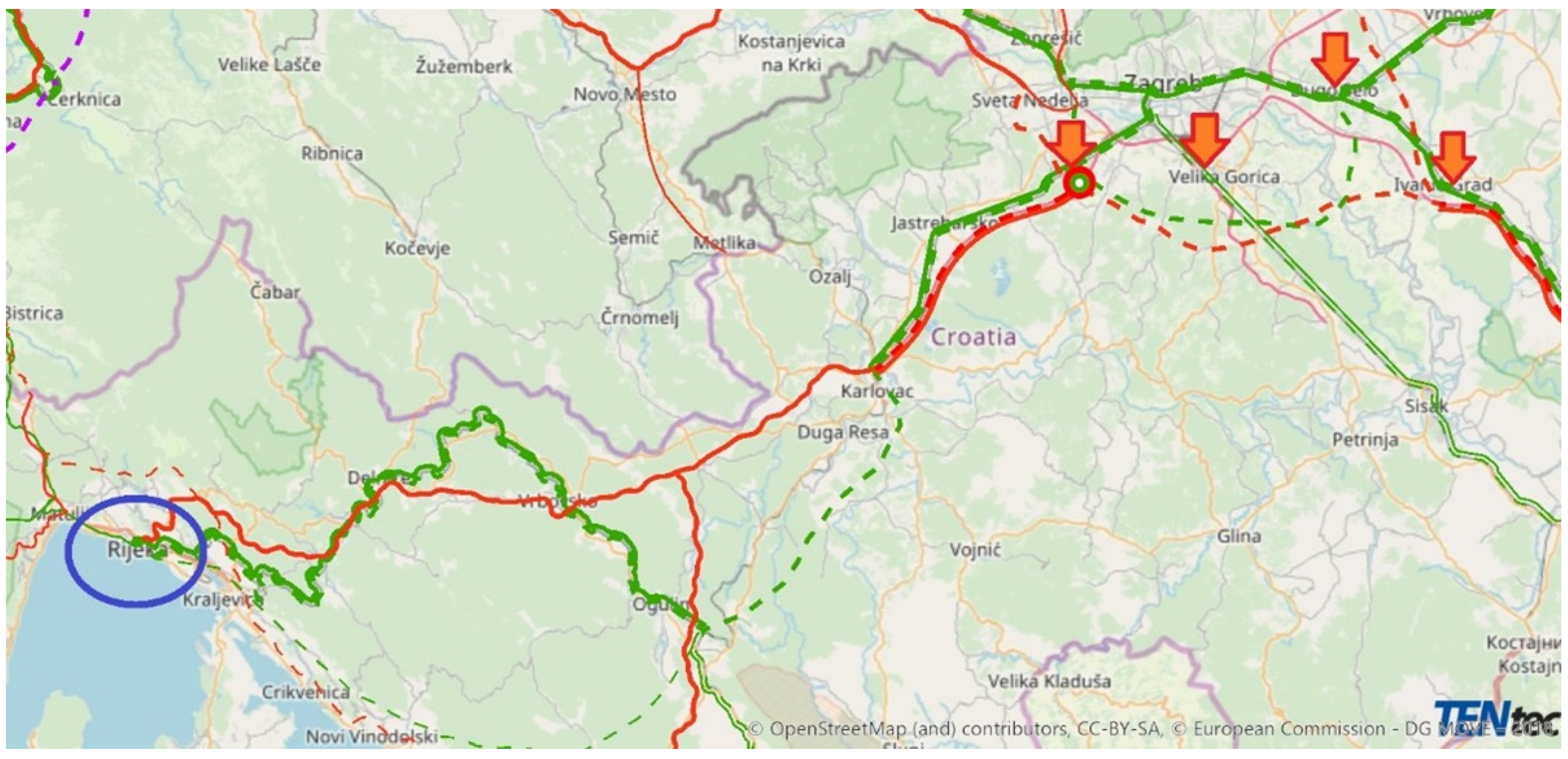
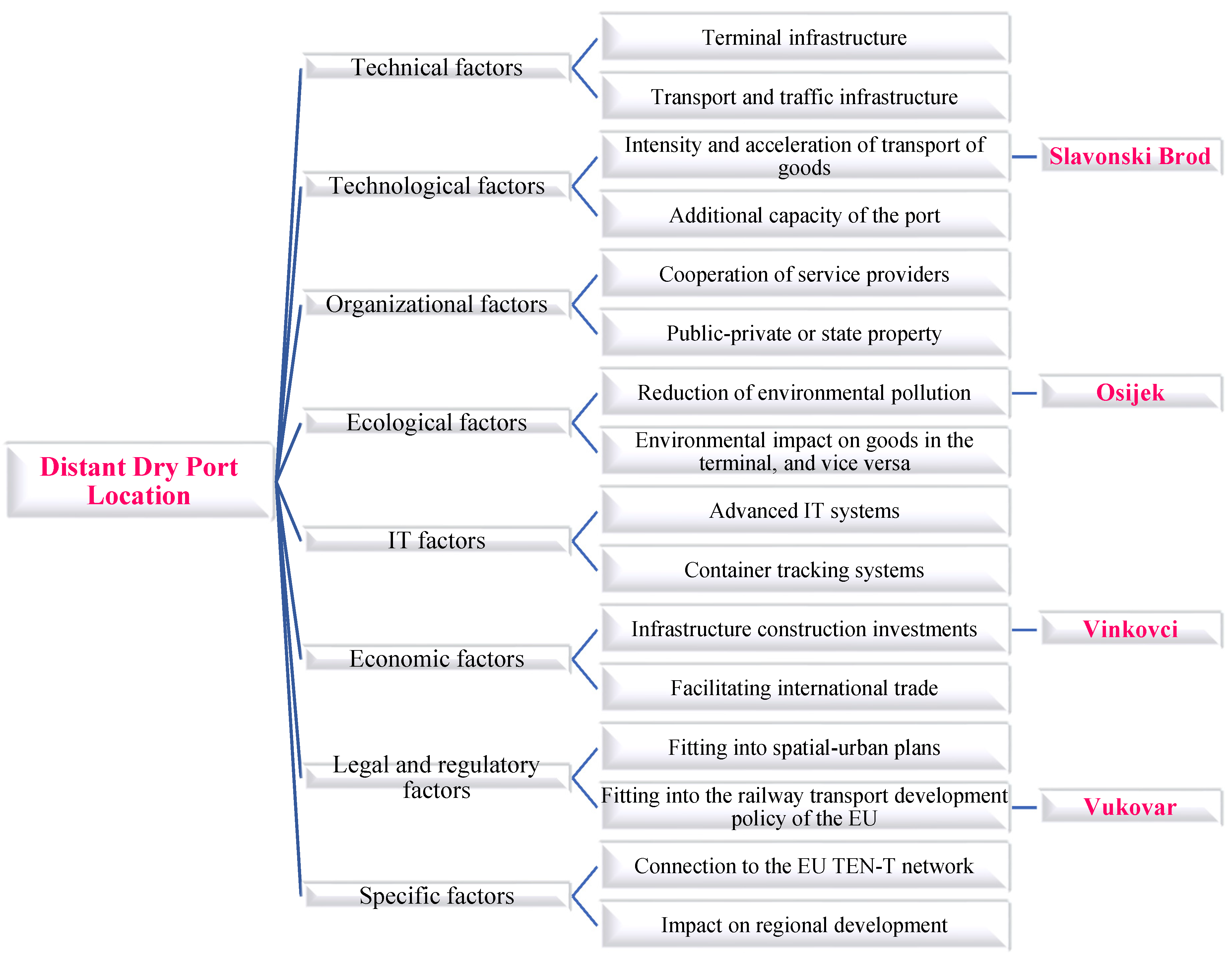
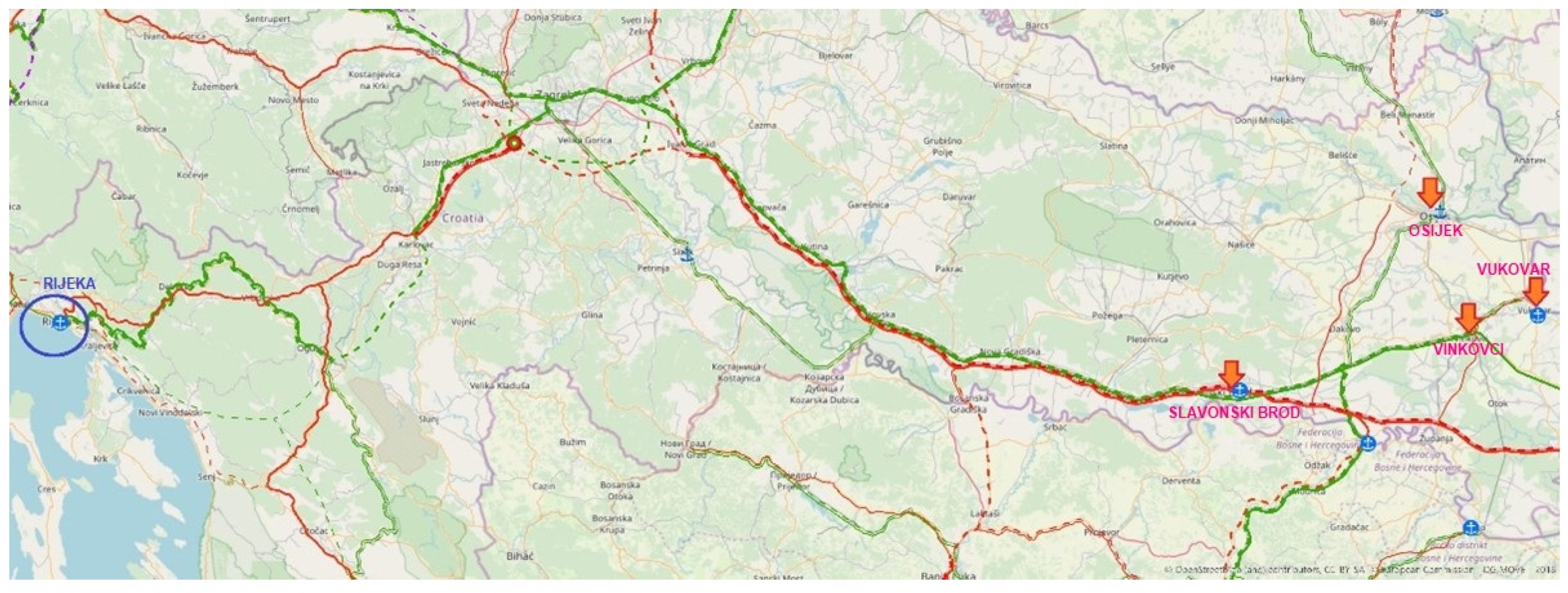



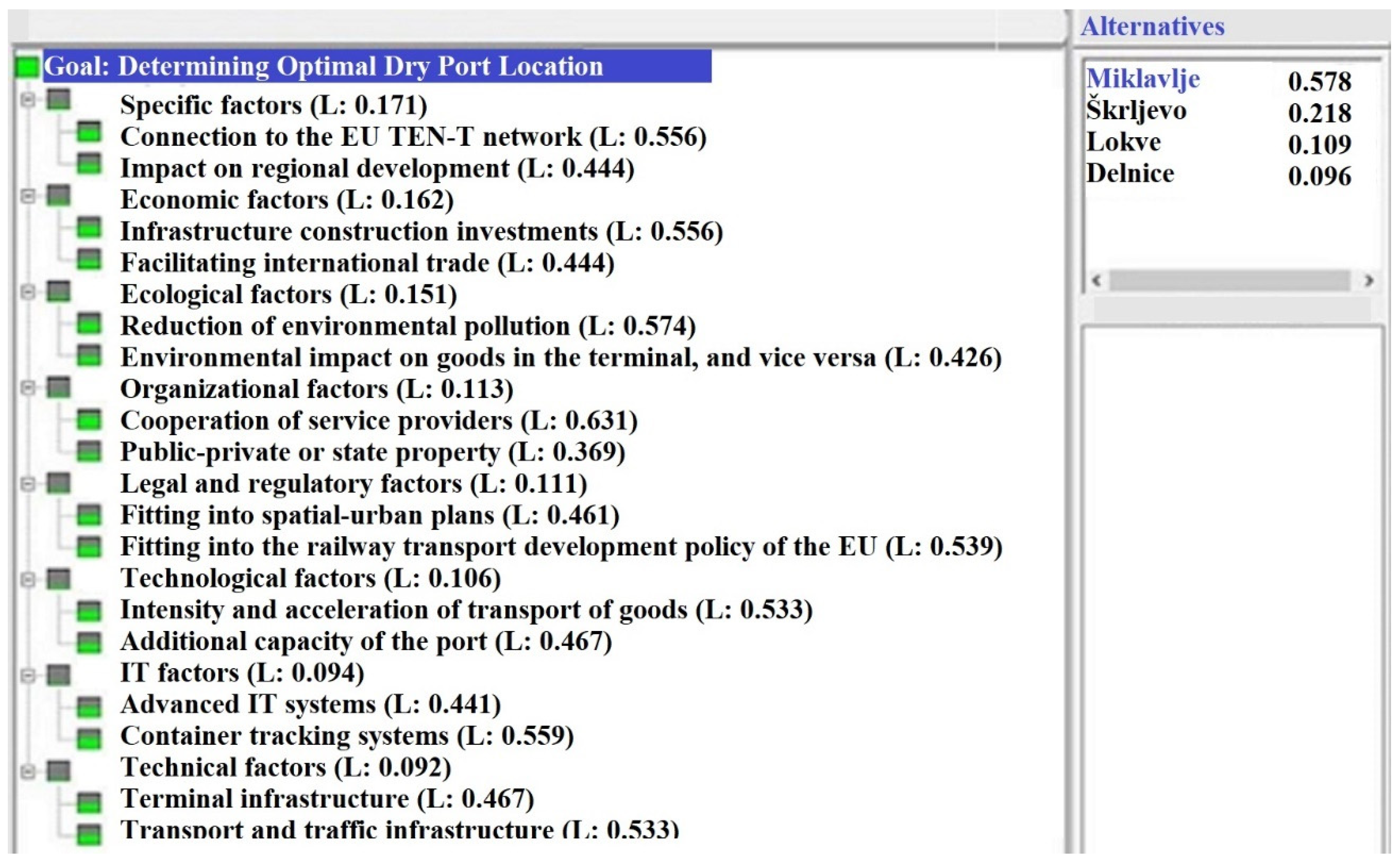
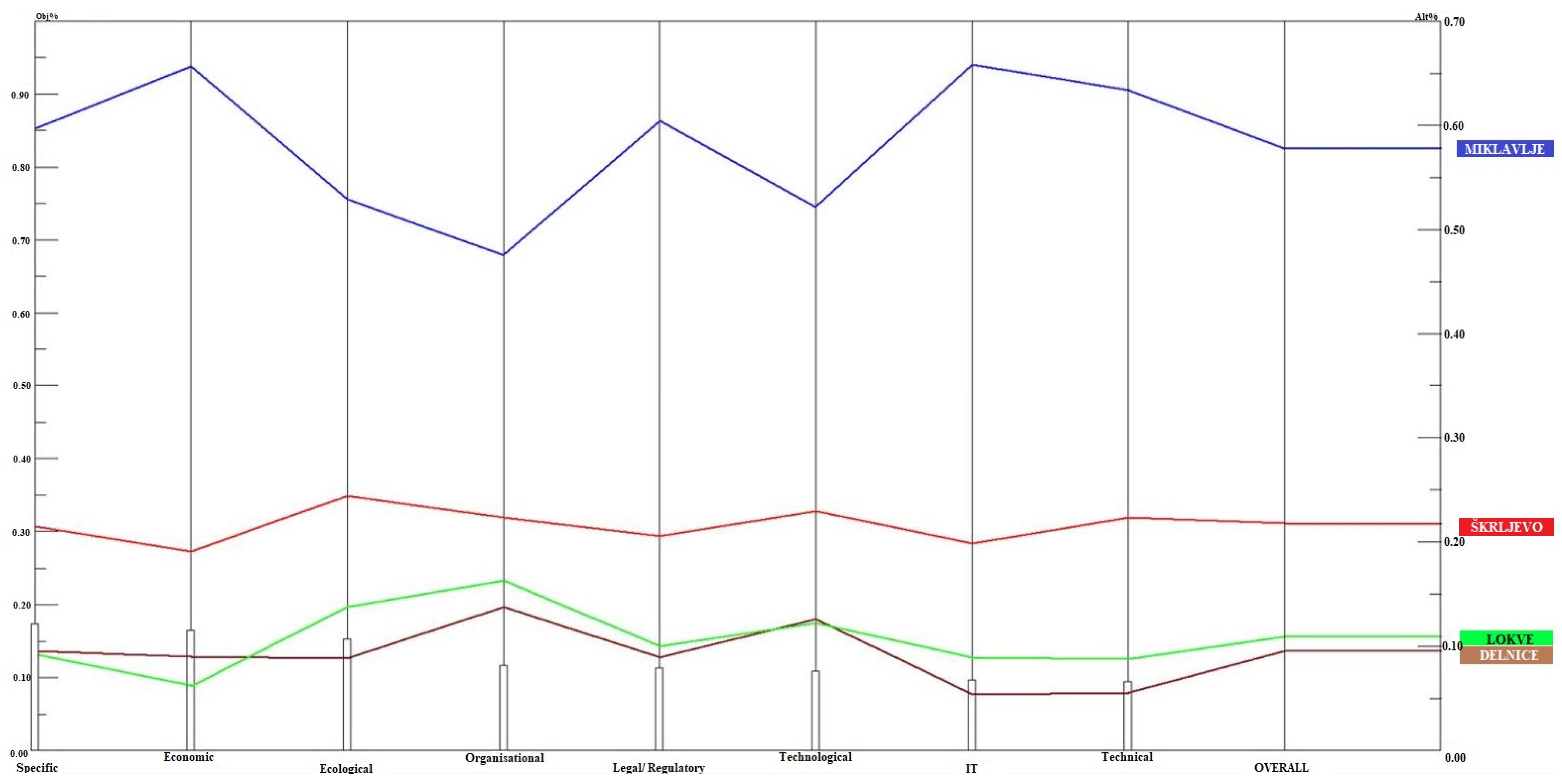
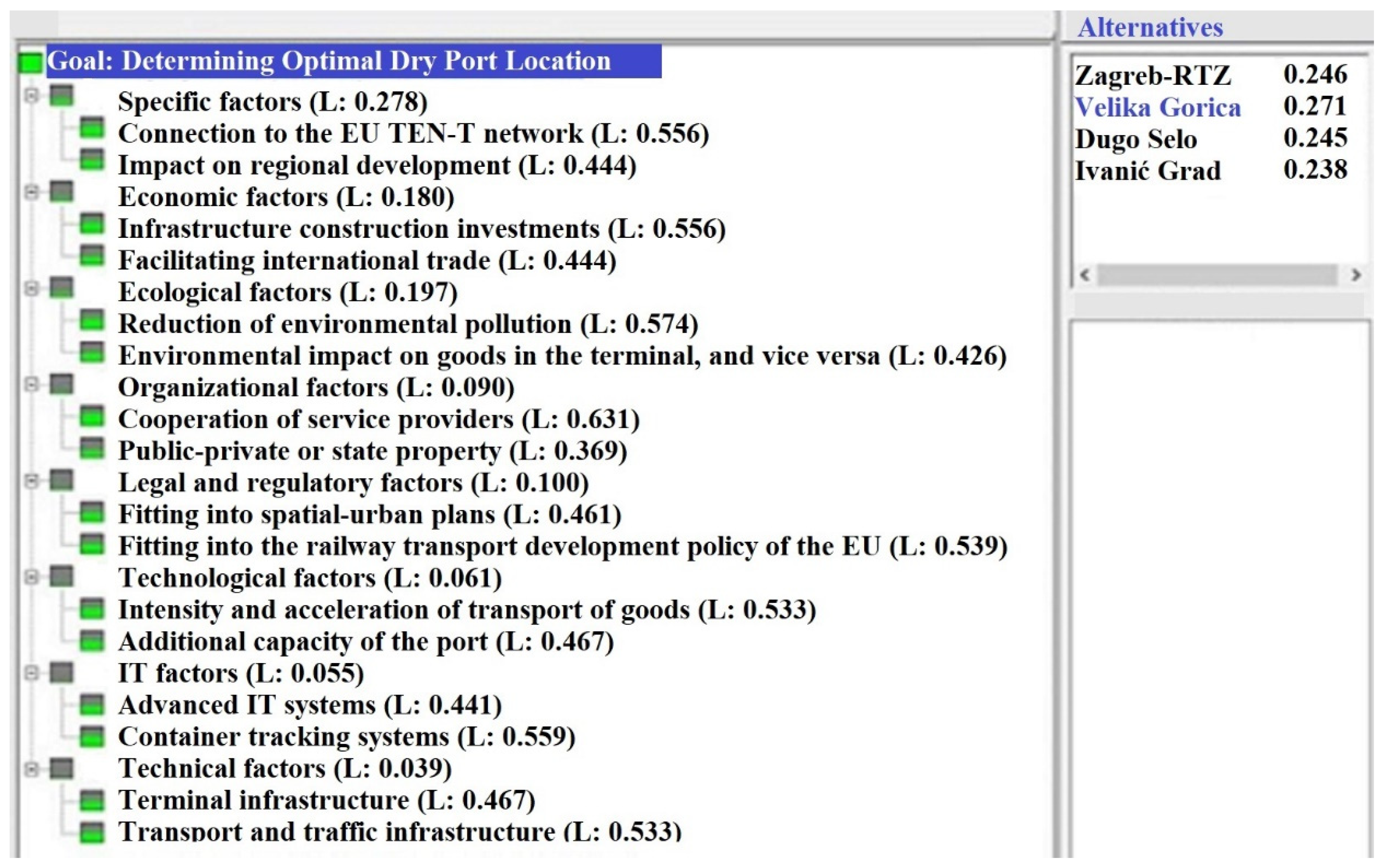
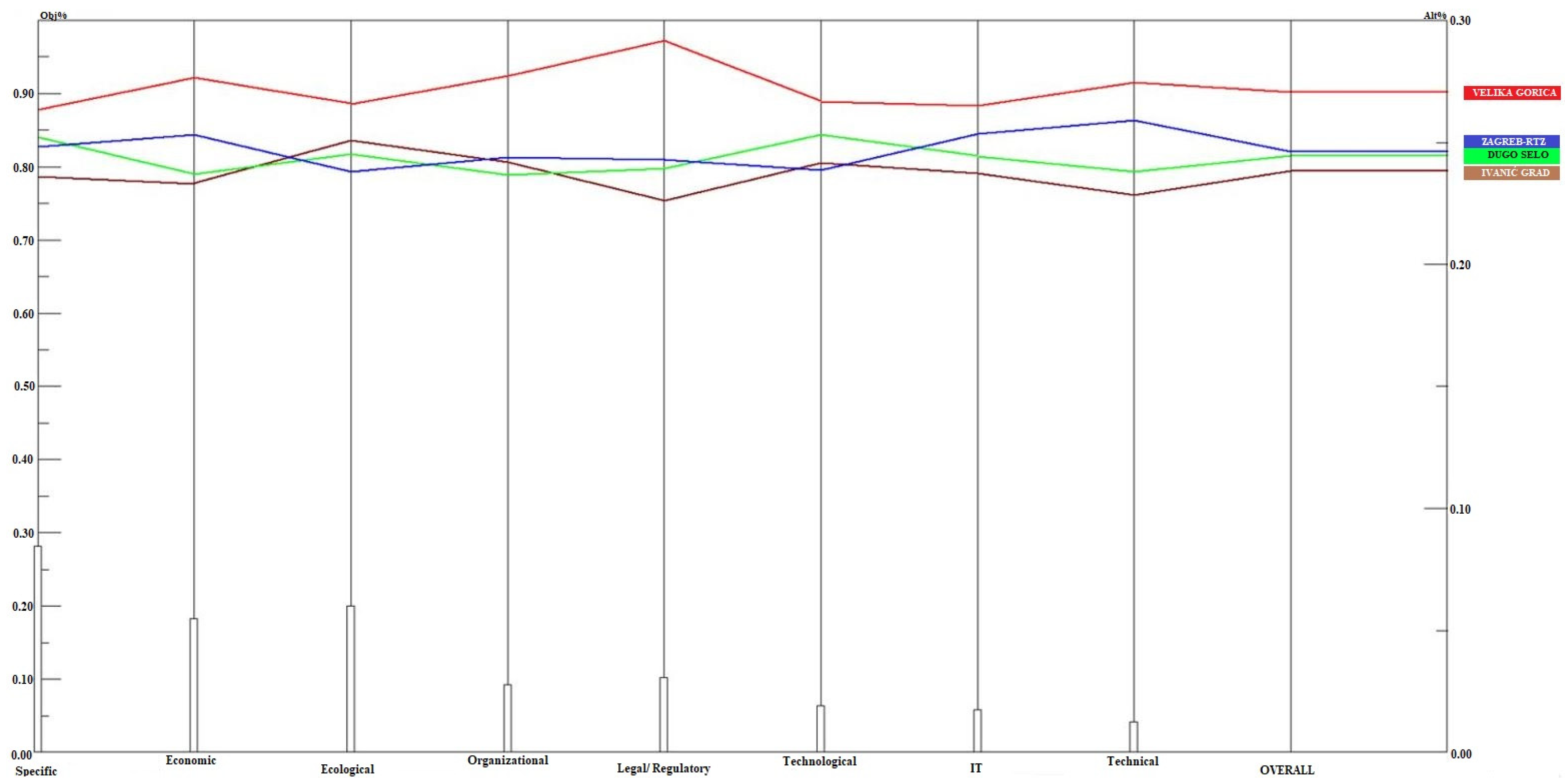
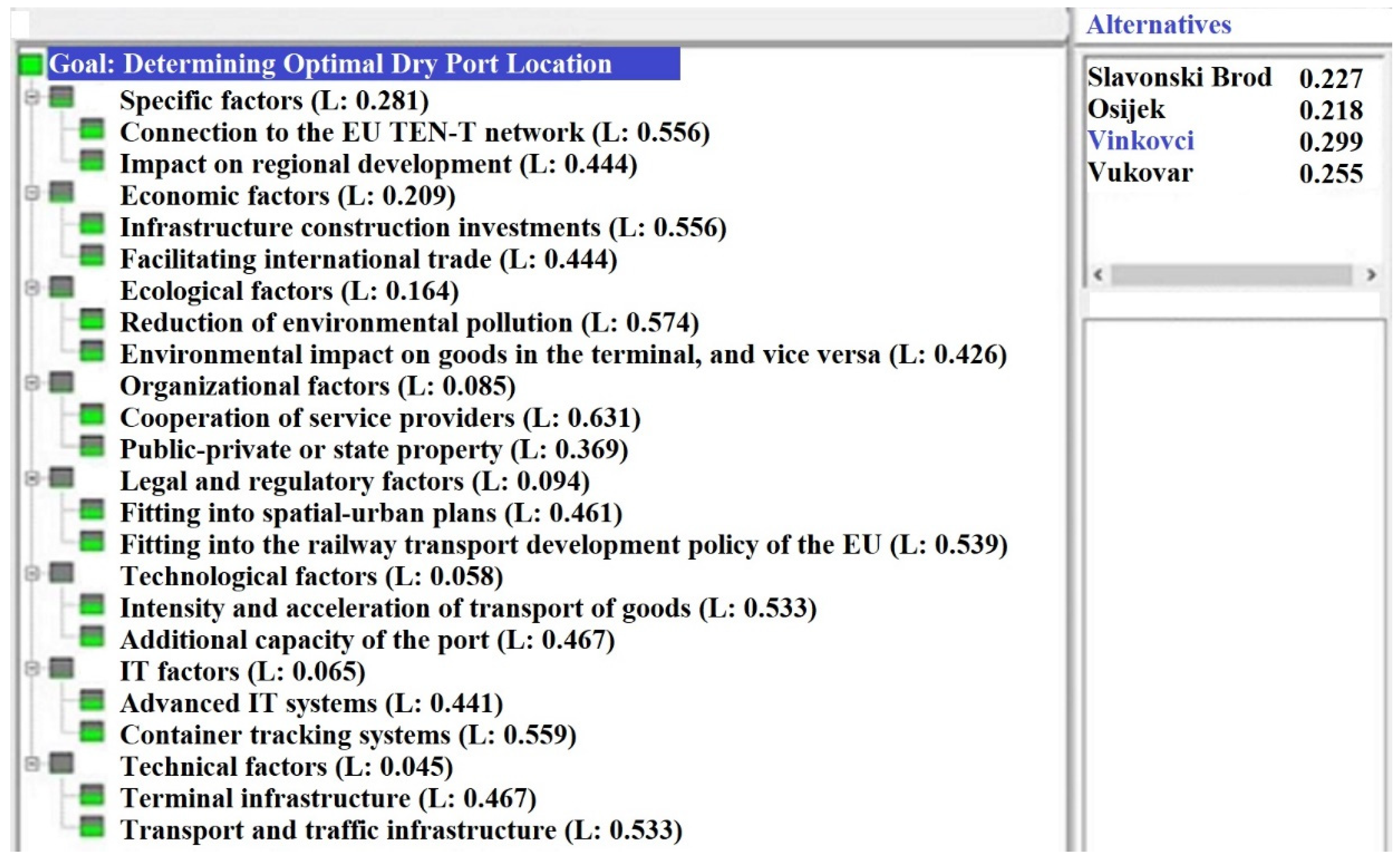
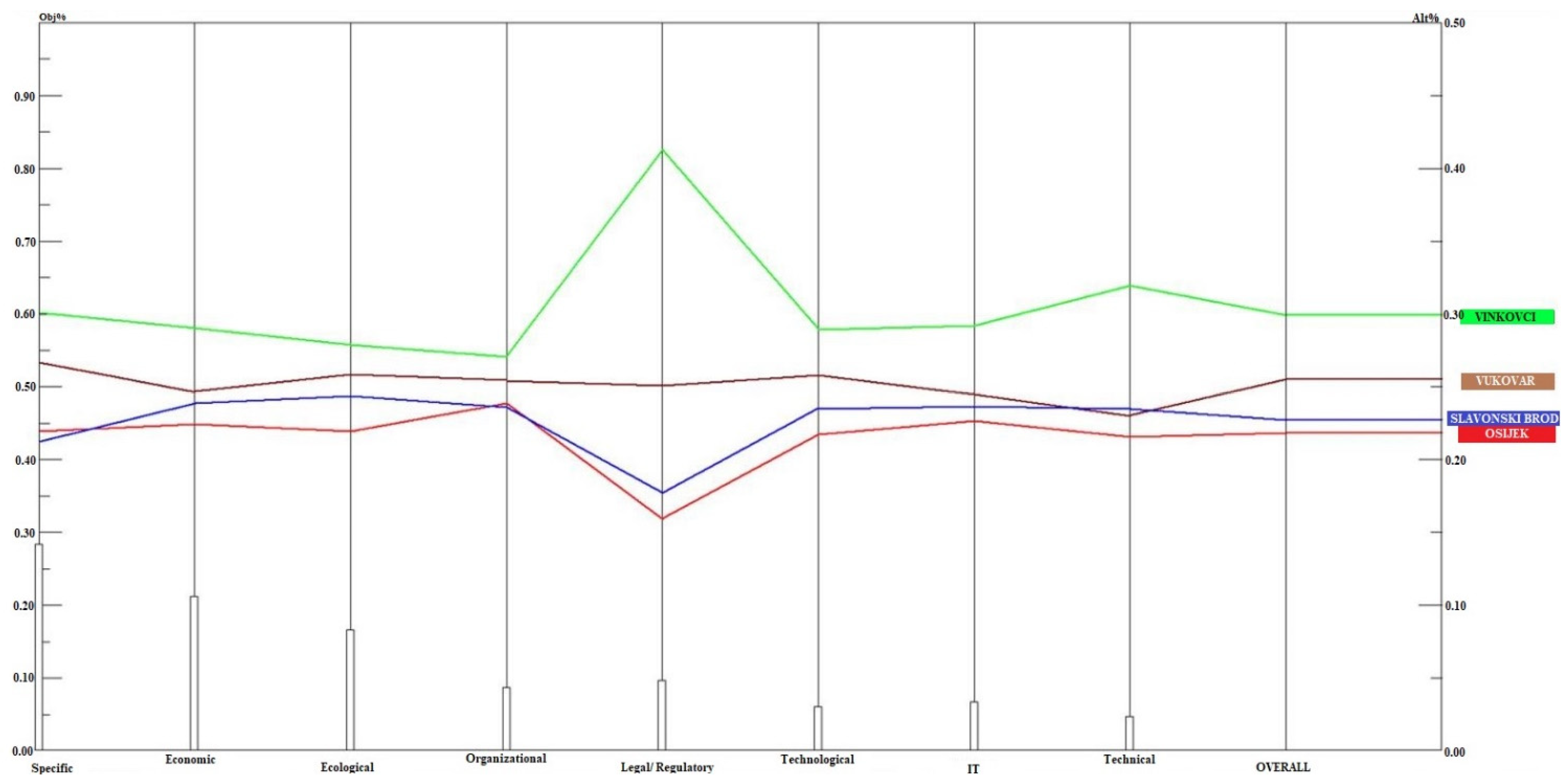
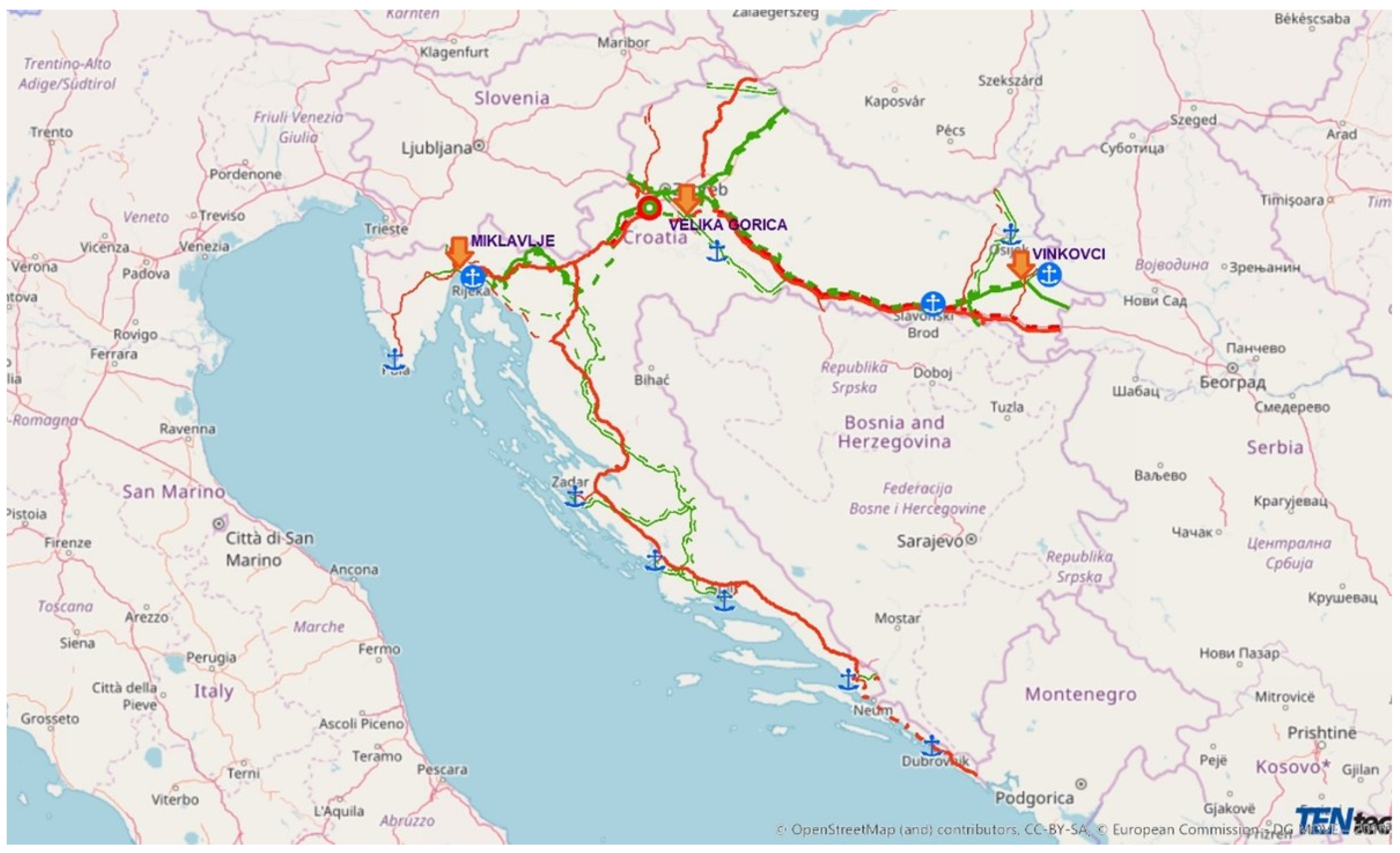
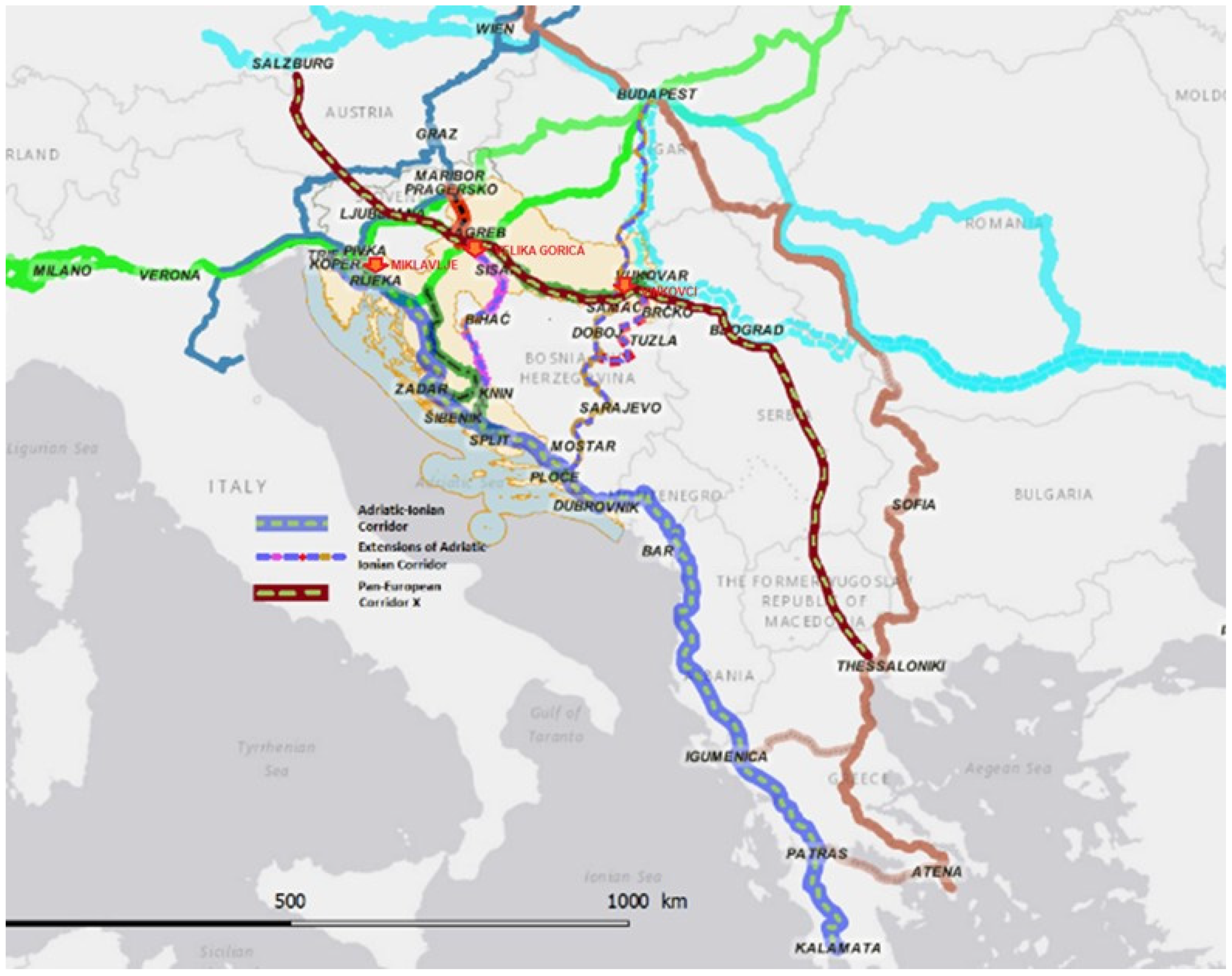
| LOCATION ASPECT— DETERMINATION OF THE OPTIMAL LOCATION OF A DRY PORT | Technical Factors | Technological Factors | Organizational Factors | Ecological Factors | IT Factors | Economic Factors | Legal and Regulatory Factors | Specific Factors |
| Dry port terminal infrastructure (capacity and condition) | Intensity of transport flows and acceleration of transport of goods by establishing a dry port | Presence and cooperation of dry port service providers (operators, representative offices, associations, etc.) | Reduction in harmful emissions/reduction in air and soil pollution | Advanced IT systems | Investments in the construction of access roads and terminal infrastructure | Fitting into spatial-urban plans and complying with all applicable regulations | Connection to the TEN-T network | |
| Dry port transport infrastructure (road, rail, intermodal, etc.; capacity and condition) | Providing additional capacity and relieving the activities of the seaport by establishing a dry port | Public–private or state ownership (dry port organizational structure) | The impact of the environment on the goods in the terminal and the impact of the goods and processes in the terminal on the environment | Container tracking systems | Facilitating international trade and encouraging economic development | Integration into the railway transport development policy in the EU | Impact on regional development |
| LOCATION ASPECT | Technical Factors | Technological Factors | Organizational Factors | Ecological Factors | IT Factors | Economic Factors | Legal and Regulatory Factors | Specific Factors |
| Terminal infrastructure (capacity and condition) | Intensity of transport flows | Presence of logistics operators in the dry port | Reduction in harmful emissions/Reduction in air and soil pollution | Advanced IT systems | Logistics costs (transport, storage, supplies, etc.) | Fitting into spatial-urban plans | Expanding to/strengthening the hinterland | |
| Infrastructure network (electricity, water, drainage, etc.) | Dry port terminal availability | Logistics policy/government support | Noise and vibration | Container tracking systems | Location activation costs | Possibility of ownership regulation of land and facilities | Connection to the TEN-T network | |
| Geological characteristics of dry port terrain | Transport time of goods | Presence of intermodal transport operators | Hazardous materials | Investments in the construction of access roads and infrastructure | Simplification of institutional and regulatory frameworks | Connection to the other relevant hubs/terminals | ||
| Rail transport infrastructure | Connection with several modes of transport | Possibility of organizing line connections in railway transport | Dangerous goods | Net present value | Regulations related to the handling of goods (dangerous goods) and terminal equipment | Impact on regional development | ||
| Infrastructure for double-deck trains | Availability of intermodal transport terminals | Cooperation of participants in the transport system (representative offices, associations, companies in the field of transport and logistics, etc.) | Influence of the environment on the goods in the terminal | Refund period | Compliance with laws governing the presence, distance and protection of the terminal environment, control and status of goods in the terminal | |||
| Road transport infrastructure | Ensuring additional seaport capacity | Agreements on operational agreements | The impact of goods and processes in the terminal on the environment | Impact on market development | Fitting into the railway transport development policy in the EU | |||
| Intermodal infrastructure | Relieving seaport activities | Public-private or state property | Facilitating international trade | |||||
| Required manpower | Development of value-added services | Coordination between different government agencies | Encouraging economic development | |||||
| Better utilization of regional transport infrastructure | Lower distribution cost | |||||||
| Lower land costs and taxes | ||||||||
| Marketing support of local economic agencies and the state | ||||||||
| Gravity of developed economy |
| No. | Category | No. | Factors | DRY PORT LOCATION ALTERNATIVES | |||||||||||
|---|---|---|---|---|---|---|---|---|---|---|---|---|---|---|---|
| Close Dry Port Location Alternatives | Mid-Range Dry Port Location Alternatives | Distant Dry Port Location Alternatives | |||||||||||||
| Miklavlje | Škrljevo | Lokve | Delnice | Zagreb-RTZ | Velika Gorica | Dugo Selo | Ivanić Grad | Slavonski Brod | Osijek | Vinkovci | Vukovar | ||||
| [1] | Technical factors | [1] | Terminal infrastructure | 0.675 | 0.192 | 0.087 | 0.046 | 0.270 | 0.271 | 0.238 | 0.222 | 0.229 | 0.229 | 0.312 | 0.230 |
| [2] | Transport and traffic infrastructure | 0.601 | 0.247 | 0.089 | 0.063 | 0.250 | 0.279 | 0.238 | 0.234 | 0.240 | 0.204 | 0.326 | 0.230 | ||
| [2] | Technological factors | [3] | Intensity and acceleration of transport of goods | 0.514 | 0.223 | 0.149 | 0.114 | 0.239 | 0.265 | 0.253 | 0.243 | 0.226 | 0.215 | 0.298 | 0.260 |
| [4] | Additional capacity of the port | 0.531 | 0.237 | 0.091 | 0.141 | 0.238 | 0.269 | 0.253 | 0.239 | 0.245 | 0.219 | 0.280 | 0.256 | ||
| [3] | Organizational factors | [5] | Cooperation of service providers | 0.431 | 0.246 | 0.189 | 0.135 | 0.252 | 0261 | 0.248 | 0.238 | 0.233 | 0.233 | 0.275 | 0.259 |
| [6] | Public–private or state property | 0.579 | 0.172 | 0.104 | 0.145 | 0.227 | 0.309 | 0.214 | 0.249 | 0.241 | 0.249 | 0.264 | 0.246 | ||
| [4] | Ecological factors | [7] | Reduction in environmental pollution | 0.661 | 0.209 | 0.077 | 0.053 | 0.233 | 0.271 | 0.241 | 0.255 | 0.240 | 0.216 | 0.278 | 0.266 |
| [8] | Environmental impact on goods in the terminal, and vice versa | 0.417 | 0.274 | 0.190 | 0.119 | 0.244 | 0.259 | 0.251 | 0.246 | 0.248 | 0.224 | 0.280 | 0.248 | ||
| [5] | IT factors | [9] | Advanced IT systems | 0.652 | 0.212 | 0.081 | 0.055 | 0.254 | 0.268 | 0.240 | 0.238 | 0.247 | 0.230 | 0.281 | 0.242 |
| [10] | Container tracking systems | 0.663 | 0.187 | 0.097 | 0.053 | 0.253 | 0.263 | 0.247 | 0.236 | 0.228 | 0.224 | 0.301 | 0.247 | ||
| [6] | Economic factors | [11] | Infrastructure construction investments | 0.642 | 0.202 | 0.066 | 0.090 | 0.265 | 0.280 | 0.232 | 0.224 | 0.244 | 0.222 | 0.288 | 0.247 |
| [12] | Facilitating international trade | 0.678 | 0.175 | 0.057 | 0.089 | 0.239 | 0.272 | 0.244 | 0.245 | 0.232 | 0.228 | 0.294 | 0.246 | ||
| [7] | Legal and regulatory factors | [13] | Fitting into spatial-urban plans | 0.516 | 0.241 | 0.139 | 0.103 | 0.233 | 0.295 | 0.251 | 0.222 | 0.183 | 0.172 | 0.402 | 0.242 |
| [14] | Fitting into the railway transport development policy of the EU | 0.708 | 0.165 | 0.055 | 0.072 | 0.252 | 0.289 | 0.230 | 0.229 | 0.172 | 0.147 | 0.422 | 0.258 | ||
| [8] | Specific factors | [15] | Connection to the EU TEN-T network | 0.632 | 0.220 | 0.062 | 0.086 | 0.250 | 0.263 | 0.253 | 0.234 | 0.219 | 0.207 | 0.317 | 0.257 |
| [16] | Impact on regional development | 0.559 | 0.210 | 0.126 | 0.106 | 0.246 | 0.264 | 0.252 | 0.238 | 0.205 | 0.234 | 0.283 | 0.278 | ||
| 0.578 | 0.218 | 0.109 | 0.096 | 0.246 | 0.271 | 0.245 | 0.238 | 0.227 | 0.218 | 0.299 | 0.255 | ||||
| 1. | 2. | 3. | 4. | 2. | 1. | 3. | 4. | 3. | 4. | 1. | 2. | ||||
Publisher’s Note: MDPI stays neutral with regard to jurisdictional claims in published maps and institutional affiliations. |
© 2021 by the authors. Licensee MDPI, Basel, Switzerland. This article is an open access article distributed under the terms and conditions of the Creative Commons Attribution (CC BY) license (https://creativecommons.org/licenses/by/4.0/).
Share and Cite
Božičević, J.; Lovrić, I.; Bartulović, D.; Steiner, S.; Roso, V.; Pašagić Škrinjar, J. Determining Optimal Dry Port Location for Seaport Rijeka Using AHP Decision-Making Methodology. Sustainability 2021, 13, 6471. https://doi.org/10.3390/su13116471
Božičević J, Lovrić I, Bartulović D, Steiner S, Roso V, Pašagić Škrinjar J. Determining Optimal Dry Port Location for Seaport Rijeka Using AHP Decision-Making Methodology. Sustainability. 2021; 13(11):6471. https://doi.org/10.3390/su13116471
Chicago/Turabian StyleBožičević, Josip, Ivica Lovrić, Dajana Bartulović, Sanja Steiner, Violeta Roso, and Jasmina Pašagić Škrinjar. 2021. "Determining Optimal Dry Port Location for Seaport Rijeka Using AHP Decision-Making Methodology" Sustainability 13, no. 11: 6471. https://doi.org/10.3390/su13116471
APA StyleBožičević, J., Lovrić, I., Bartulović, D., Steiner, S., Roso, V., & Pašagić Škrinjar, J. (2021). Determining Optimal Dry Port Location for Seaport Rijeka Using AHP Decision-Making Methodology. Sustainability, 13(11), 6471. https://doi.org/10.3390/su13116471







